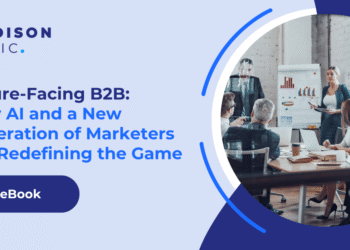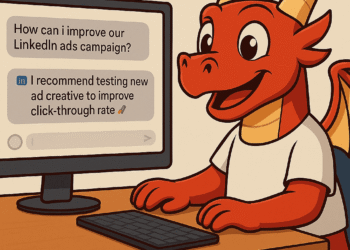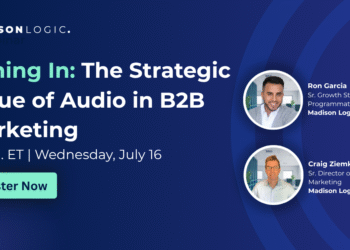What is B2B Advertising?
Business-to-business (B2B) advertising is the practice of promoting products or services from one business to another.
Unlike B2C (business-to-consumer) marketing, B2B advertising focuses on targeting key decision-makers within organisations, such as procurement managers, department heads, or C-level executives, who influence or control purchasing decisions.
In B2B advertising, the buying journey is typically longer and more complex, involving multiple stakeholders and touchpoints. The objective is often to generate leads, nurture relationships, and build trust over time, rather than quick conversions.
How B2B Advertising Differs from B2C
| Aspect | B2B Advertising | B2C Advertising |
|---|---|---|
| Target Audience | Businesses, decision-makers and researchers | Individual consumers |
| Sales Cycle | Long and complex | Short and impulsive |
| Messaging | Value, ROI, pain points using emotion, and storytelling | Emotional appeal, lifestyle |
| Purchase Size | Larger deals, long-term | Smaller, one-off purchases |
| Channels | LinkedIn, trade media, email, Display, Out of Home, Reddit | Instagram, TikTok, TV, Reddit, Out of Home, Display |
Core B2B Advertising Strategies
- Understand Your Audience: Identify industry segments, job roles, and company sizes most relevant to your offer. Then look a level deeper. Read how in our post on Ideal Customer Profiles.
- Choose the Right Channels: Mix your channels based on high-intent and high-engagement platforms like LinkedIn, Google Ads, programmatic display, and combine with high awareness channels like programmatic display, Google Ads and trade publications.
- Personalise Messaging: Tailor your ads based on the buyer’s stage in the funnel and pain points.
- Leverage Intent Data: Use platforms like Radiate B2B to identify in-market buyers to drive more engagement for less overall media spend.
- Retarget and Nurture: Stay top of mind with retargeting and automated nurture sequences. This is the foundation of any good advertising programme as it is relatively low cost to implement and reinforces your message with an already warm audience.
- Measure and Optimise: Track CAC, Opportunity conversion rates (over a period of time reflective of the sales cycle), ROI, and dwell time. Then refine your targeting and messaging accordingly.
Top B2B Advertising Channels
1. LinkedIn Advertising
- Best for targeting by individual, company or more broadly by job title, industry, and company size. Include group memberships, interests and job skills to further narrow where necessary.
- Ideal for lead gen and nurturing an audience from cold through to close.
- Combine with intent data to automatically target companies interested in your market.
2. Google Ads
- Capture high-intent buyers actively searching for solutions.
- Use keyword targeting, extensions, and landing pages.
3. Programmatic Display, Company-Driven & Intent-Driven Ads
4. Content Syndication & Native Ads
- Publish whitepapers, case studies, or ebooks across third-party platforms.
5. Trade Publications & Print
- Highly relevant for niche B2B audiences (e.g., tech, logistics, law, accounting, consulting etc).
B2B Advertising Strategy Framework
Step-by-Step Process:
- Audience Research – Define Ideal Customer Profiles (ICPs), job titles, industries and what makes them ideal to you.
- Channel Selection – Choose paid, owned, and earned media mix. We can help you with specific frameworks within LinkedIn, Display, YouTube and Reddit channels.
- Creative Development – Tailor messaging and visuals to the buyer journey.
- Landing Page Optimisation – Ensure strong CTA and lead capture. Landing pages today have between a 5 and 10% conversion rate. You can improve this within LinkedIn Advertising, in certain situations, by 20-25% using LinkedIn forms that allow users to convert without leaving LinkedIn.
- Campaign Execution – Launch ads, monitor pacing.
- Performance Analysis – Track KPIs and adjust. KPIs should vary based on where the advertising sits in the buyer journey. For example, awareness campaigns would monitor reach, dwell time and engagement metrics, while the consideration phase would focus more on click rate, conversion rate and opportunity generation.
Examples of B2B Advertising Campaigns
IBM – “Outthink Hidden” Campaign
Objective: Promote IBM Watson’s AI capabilities to enterprise decision-makers across industries, positioning IBM as the leader in enterprise AI.
What They Did Well
1. Insight-Driven Strategy:
IBM understood that enterprise buyers were overwhelmed by AI hype but lacked clarity on its real, practical value. The campaign’s strategy revolved around uncovering “hidden patterns, insights, and threats” that AI could surface—something enterprise leaders found both urgent and valuable.
2. Persona Targeting with Precision:
They targeted key verticals (e.g., finance, healthcare, logistics) with tailored messages showing Watson solving industry-specific problems. The campaign reached C-level execs, IT buyers, and line-of-business leaders using a mix of intent data, ABM targeting, and third-party partnerships.
3. Omni-Channel Execution:
IBM combined high-visibility channels like LinkedIn, programmatic display, business podcasts, and print (e.g. WSJ, Economist) with owned media, events, and immersive digital content hubs.
Creative Approach
Visual Design:
- Used dark, high-contrast visuals with abstract data patterns and hints of human elements (e.g. faces half-revealed in data swirls) to represent AI “uncovering the hidden.”
- High-end cinematic video assets and clean, futuristic typography signaled IBM’s premium positioning.
Messaging:
- Core tagline: “Outthink Hidden”—short, enigmatic, but intriguing. A play on the word “outthink” (aligned to IBM’s broader brand theme) that suggests action and competitive edge.
- Sub-messaging varied by industry:
- “Outthink Disease” (healthcare)
- “Outthink Risk” (financial services)
- “Outthink Supply Chain Disruptions” (logistics)
Content Depth:
- Each vertical had its own microsite or interactive content experience featuring white papers, video case studies, and ROI calculators.
- AI demos and tools were available to try directly from ad journeys—bridging interest to product experience quickly.
Results & Impact
- IBM reported a 6x lift in engagement on Watson product pages from targeted users.
- Clickthrough rates on LinkedIn outperformed benchmarks by over 200%.
- The campaign drove significant inbound enterprise leads, contributing to Watson’s rise in brand preference surveys.
Key Takeaways for Your Own Campaigns
- Anchor in a powerful human insight—don’t just sell tech, sell the problem it solves in a tangible way.
- Creative should reflect the product’s value visually—in this case, surfacing the “unseen.”
- Combine broad awareness with narrow precision—use ABM and personalization to speak directly to industry-specific pain points.
- Don’t just inform—immerse. Content should let the user experience the product, not just read about it.



Creative Approaches in B2B Advertising
- Storytelling: Use narratives to connect emotionally (even in B2B).
- Data Visualisation: Infographics showing ROI or market stats.
- Humour: When relevant, it can break through corporate noise.
- Personalisation: Dynamic ad content based on viewer’s industry or job role.
B2B Advertising Trends to Watch in 2025
- AI-Powered Personalisation: Tailor ads in real time based on behaviour and firmographics.
- Privacy-First Targeting: While Google is no longer explicitly removing third party cookies, requiring explicit opt-in will be the nail in the coffin. So with third-party cookies phasing out, platforms like Radiate B2B (using company and industry targeted Display campaigns, which do not use third party cookies), LinkedIn and context relevant channels alongside first-party intent data will grow in adoption.
- Interactive Formats: From in-ad forms to video Q&A content.
- ABM Expansion: More tightly targeted, cross-channel account-based marketing campaigns.
- Voice Search & Smart Assistants: Optimising content and ads for voice queries is increasingly important.
Common Metrics & KPIs in B2B Advertising
Cost Per Lead (CPL)
Measures the cost incurred to acquire a single lead. A lead is a potential customer who has shown interest in your product or service, typically by filling out a form, downloading content, or requesting a demo.
Formula: CPL = Total Campaign Spend divided by the Number of Leads Generated
Example: If you spend £5,000 on a LinkedIn ad campaign and generate 100 leads:
CPL=£5,000 divided by 100 = £50
This means you’re spending £50 to acquire each lead.
Customer Acquisition Cost (CAC)
Measures the total cost of acquiring a new paying customer, including all sales and marketing expenses over a specific period.
Formula: CAC = Total Sales & Marketing Cost divided by the Number of new Customers acquired.
Total Sales & Marketing costs include:
- Advertising spend (digital, events, etc.)
- Sales team salaries and commissions
- Marketing software and tools
- Creative, content, and agency costs
- Any overhead directly tied to acquiring customers
Example: If your company spends £100,000 on sales and marketing in a quarter and acquires 50 new customers:
CAC = £100,000 divided by 50 = £2,000
So, it costs £2,000 to acquire each new customer.
Marketing Qualified Leads (MQLs)
This is a lead who has shown enough interest or engagement with your marketing efforts to be considered more likely to become a customer than other leads.
They are not yet ready to buy. They’ve moved beyond basic awareness and are ready for further nurturing, either by sales development teams or by further marketing.
Sales Qualified Leads (SQLs)
This is a prospective customer who has been vetted and deemed ready for direct sales engagement. This lead has moved beyond marketing interest (MQL) and meets the criteria for a meaningful sales conversation.
SQLs usually meet a combination of:
Behavioral Indicators
- Requested a demo or trial
- Asked to speak with sales
- Replied to outreach from a business development rep (BDR) or sales development rep (SDR)
- Engaged with high-intent content
(e.g. pricing page, case studies)
Qualification Criteria
Often based on a BANT or similar framework:
Timeline, Budget, Authority (decision-maker or influencer), Need
📈 Key Differences: MQL vs. SQL
| Metric | MQL | SQL |
|---|---|---|
| Intent Level | Interest / Engagement | Purchase consideration |
| Owned By | Marketing | Sales |
| Next Step | Nurturing or qualification | Sales call or pitch |
| Common Trigger | Downloads, webinar attendance | Demo request, budget approval |
Pipeline Influence
This refers to the impact that marketing or other business activities have on the creation, acceleration, or closing of sales opportunities within the revenue pipeline. Even if those activities didn’t directly generate the lead.
Complex B2B buying journeys typically span months and require many touches to become a customer. Tracking pipeline influence allows you to understand which channels contributed to pipeline. Though note that not every touchpoint can be tracks. See more on the dark funnel to understand where you might be undermeasuring channel performance.
Return on Ad Spend (ROAS)
Measures the revenue generated for every £1 (or $1, etc.) spent on advertising. It’s a key performance indicator (KPI) used to evaluate the effectiveness and profitability of advertising campaigns.
Formula: ROAS = Revenue from Ads divided by Ad Spend
Example:
If you spend £10,000 on a LinkedIn ad campaign and generate £40,000 in revenue:
ROAS = £40,000 divided by £10,000 = 4.0
That means for every £1 spent, you earned £4 back.
Good ROAS Benchmarks (Varies by Industry):
| Business Type | Target ROAS |
|---|---|
| Enterprise SaaS | 3–5+ |
| E-commerce | 2–4 |
| B2B Lead Gen | Often lower initially, but tracked alongside LTV and CAC |
Conversion Rate by Channel
Shows the percentage of users from a specific marketing or sales channel who take a desired action. For example, filling out a form, signing up for a trial, or becoming a customer.
Formula:
Conversion Rate (Channel) = (Number of Conversions from Channel divided by Total Visitors from Channel) × 100
Example:
LinkedIn Ads: 1,000 visitors → 50 form submissions
Conversion rate = 50 divided by 1,000 × 100 = 5% conversion rate
Frequently Asked Questions
Q: Is B2B advertising really effective?
Yes—when it’s highly targeted and delivers value. Long-term campaigns that educate and build trust are especially effective.
Q: What’s the best platform for B2B advertising?
LinkedIn is the top platform for precise B2B targeting, but combining it with Google Ads and programmatic display yields the best results.
Q: How much should you spend on B2B advertising?
It depends on your goals, deal size, and funnel complexity. A monthly spend of £3,000–£10,000 is typical for mid-market companies.
Q: How do you measure success?
Ultimately, driving revenue is the requirement for B2B companies. So tracking metrics which point to an increase in revenue is critical. However, advertising should be optimised for the stage of the buying cycle.
So for companies not yet in the buying cycle, tracking engagement metrics like dwell time, reach and frequency can be important for future revenue.
As buyers enter the buying cycle, metrics like website activity, increasing intent scores, conversion rates, lead quality, pipeline influence, and ROI are important to measure. Tools like Radiate B2B help with understanding website activity, intent scoring, and conversion rates. By using company targeted advertising, leads will always be of high quality visualise and optimise these metrics.
Final Thoughts
B2B advertising in 2025 is more sophisticated, data-driven, and personalised than ever. By understanding your audience, selecting the right channels, and delivering value through every touchpoint, you can build a pipeline of high-quality opportunities.
To see how Radiate B2B can help you reach in-market buyers through AI-powered intent-based advertising, book a demo or contact us today.
About the Author
Riaz Kanani is the founder and CEO of Radiate B2B. A serial entrepreneur, B2B marketing strategist, and public speaker, Riaz has spent over two decades helping brands navigate digital transformation in marketing and sales.
He previously founded companies acquired by Silverpop (now IBM) and has been featured in The Drum, Marketing Week, and other leading publications. At Radiate B2B, he’s leading the way in applying AI and intent data to B2B advertising for maximum pipeline impact.


















